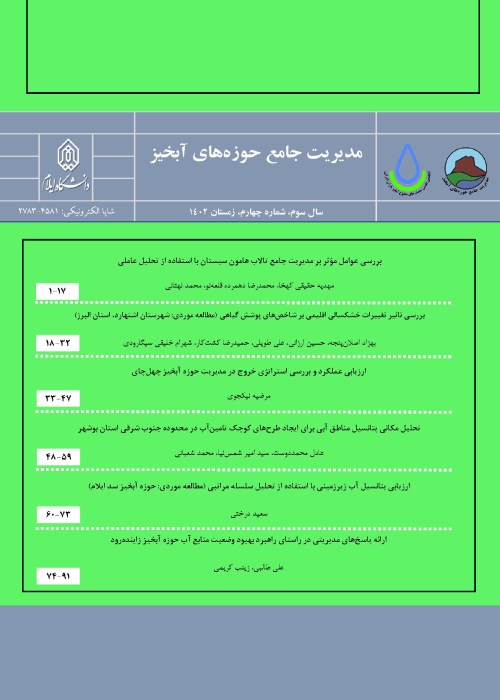Investigating the relationship between the effect of geological formations on groundwater quality (Study area: Yazd province)
Introduction :
Groundwater is one of the most important natural resources in the world. In the current situation, a significant part of Iran's consumption in the drinking sector is provided by underground water sources. In the last 20 years, salinization and reduction of groundwater quality have become one of the serious environmental problems around the world. This issue adds to the importance of proper management of groundwater consumption. Proper management of groundwater consumption is not possible without having sufficient knowledge of the distribution and expansion of saline and fresh groundwater and determining the processes influencing its evolution. Atmospheric precipitation and surface water, passing through different geological formations, dissolve the salts in them. Therefore, the chemical quality of underground water depends on the type of formation that passes through its empty spaces. Also, the time the water stays in the basement has an effective role in the quality and salinity of the water, because the longer the water stays in the sediments, the saltier it becomes.Groundwater in arid and semi-arid areas, especially in Yazd province, is the main and reliable source of water supply for various uses due to low rainfall and lack or absence of surface water sources. In order to check the condition of underground water, it is necessary to check the concentration and type of solutes in the water. One of the factors affecting the quality of underground water in Yazd province is the existence of destructive geological formations. Therefore, the purpose of this research is to investigate the relationship between the quality of underground water in Yazd province and the type of formations.
Yazd province, with an area of about 737.54 square kilometers, is located in the central part of Iran's central plateau, between 29 degrees and 52 minutes to 33 degrees and 27 minutes north latitude and 52 degrees and 55 minutes to 56 degrees and 37 minutes east longitude. Yazd province is bordered by Semnan and Isfahan provinces from the north and west, Khorasan Razavi province from the northeast, Kerman and South Khorasan provinces from the east, Fars province from the southwest, and Kerman from the southeast. It varies from about 666 meters above the level of the open sea (Zarin sand desert near Aqda) to 4075 meters (Shirkoh peak). The present research is about investigating the impact of geological formations and units on the quality of underground water in Yazd province based on the statistics, information, and reports available in the Geological Organization using a 1:100000 geological map. In order to check the quality of underground water samples, 217 wells and aqueducts of Yazd Region Water Company's monitoring network in July 2013, the measured parameters of cations (sodium, potassium, calcium and magnesium), anions The main elements (bicarbonate, chloride and sulfate) present in water, electrical conductivity (EC), dissolved solids (TDS), sodium absorption ratio (SAR) and pH were used. To check the quality of underground water, sampling has been done in 18 regions of Yazd province. RockWorks 14, ArcGIS 10.3 and Excel software were used to draw and prepare maps.
To check the groundwater type of 217 sampled points in Yazd province, the average data of each region was used. By using the main ions, samples of the type of underground water in each region have been obtained in such a way that by separating the ions and their amount in each region and then implementing them in the Piper diagram, the type of groundwater in the region is obtained. As it is clear in Piper's diagram, the predominant type of underground water in Yazd province is chloride+sulfate and calcium+magnesium. These types cover the largest area in the plains and playas, which have limestone and marl. There is also carbonate type in the region due to the presence of granite formation heights that have better quality water. The interesting point in this graph is that none of the samples are in the fresh water category. The Piper diagram shows that the groundwater of the studied area is located in the hard and completely hard water type due to the existence of terrace deposits and new low-altitude foothill alluvial cones, which cover about 3,383,512 hectares of the entire area of the region. According to the Wilcox diagram of the study area, C2S2 and C4S2 classes have the lowest and highest shares with 0.46 percent and C3S4 and C4S4 classes with 32.26 and 56.22 percent, respectively. According to the results of the Wilcox diagram of underground water in Yazd province, the water quality of the region is too salty and unsuitable for agricultural use. The results show that the high amount of salts is one of the problems of the water that is used for irrigation in this area. High concentration of salt in irrigation water can reduce the growth of crops or even prevent the growth of some crops, which results in soil decomposition and groundwater pollution. In such water, the growth of plants and their quality will be improved by increasing irrigation for washing or using intermittent water with low salinity and good drainage.
If there is a trend of pollution and over-harvesting of the underground water table in the region, in the next few years, with the increase of TDS in the region, the condition of the water in terms of drinking will become worse. The best quality of water for drinking is in the central and southwestern regions where the normal gneiss granite formation with eye grain structure is located in the mountainous area of Shirkoh, and the further we move away from the center, the worse the water quality is. The formation of these areas is of the type of terrace deposits and alluvial cones of new foothills.
- حق عضویت دریافتی صرف حمایت از نشریات عضو و نگهداری، تکمیل و توسعه مگیران میشود.
- پرداخت حق اشتراک و دانلود مقالات اجازه بازنشر آن در سایر رسانههای چاپی و دیجیتال را به کاربر نمیدهد.


